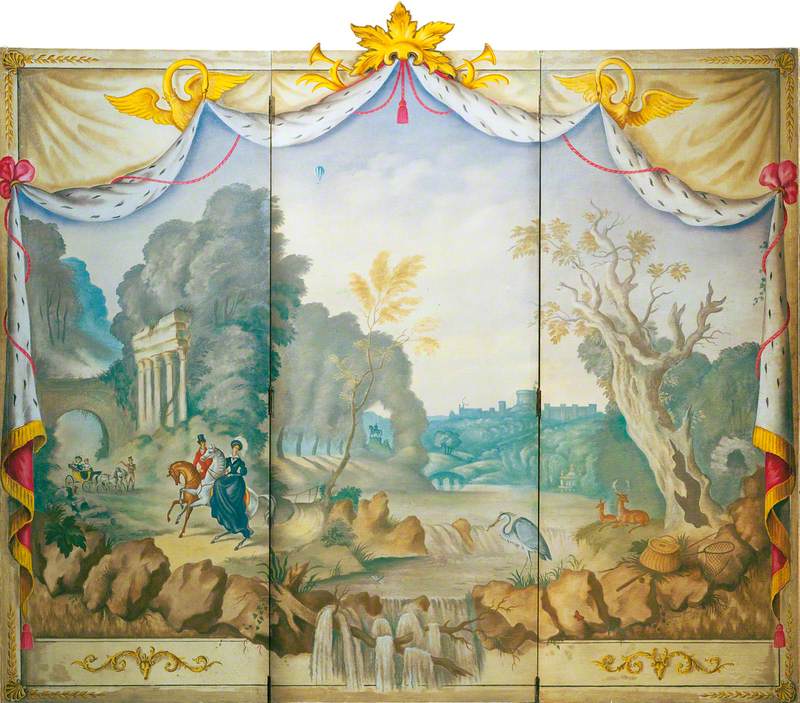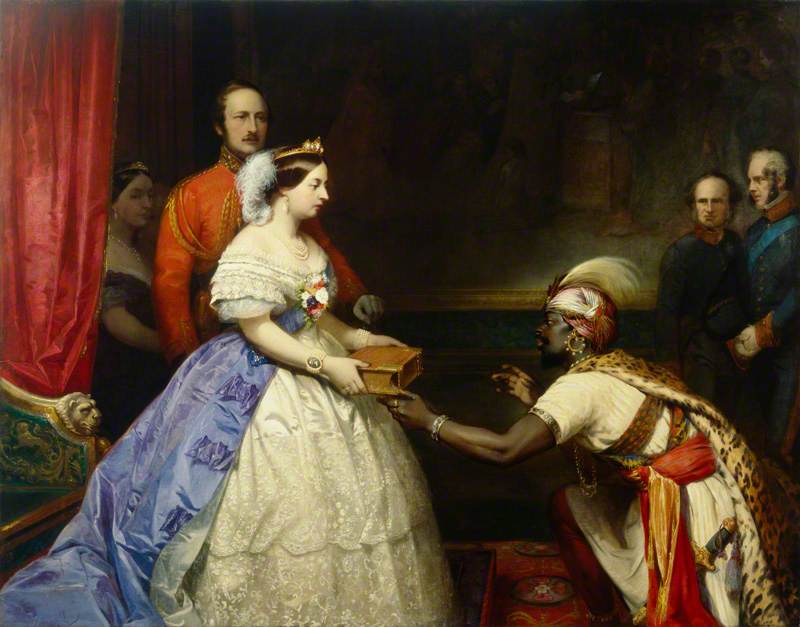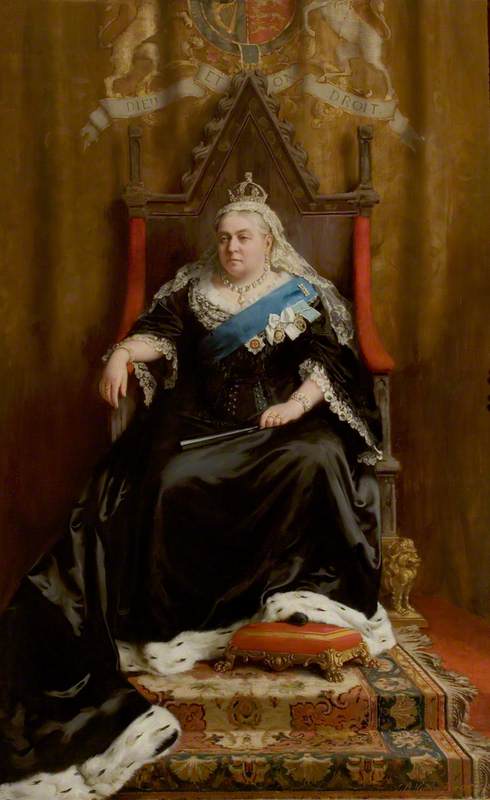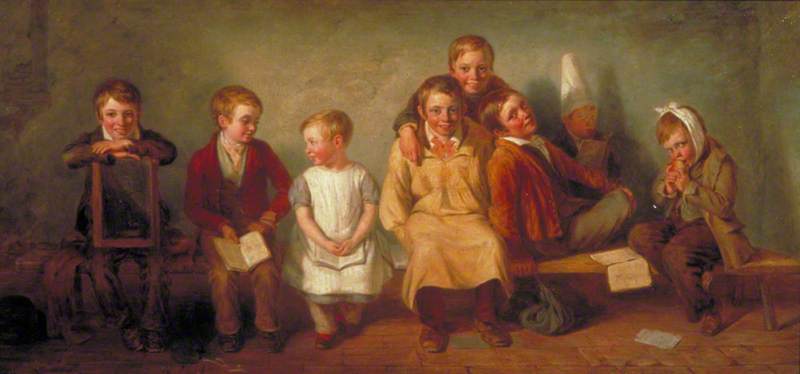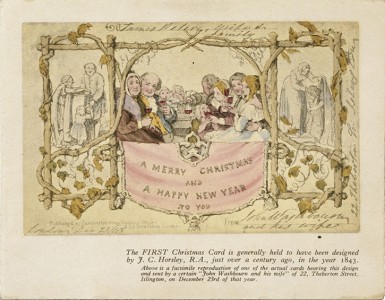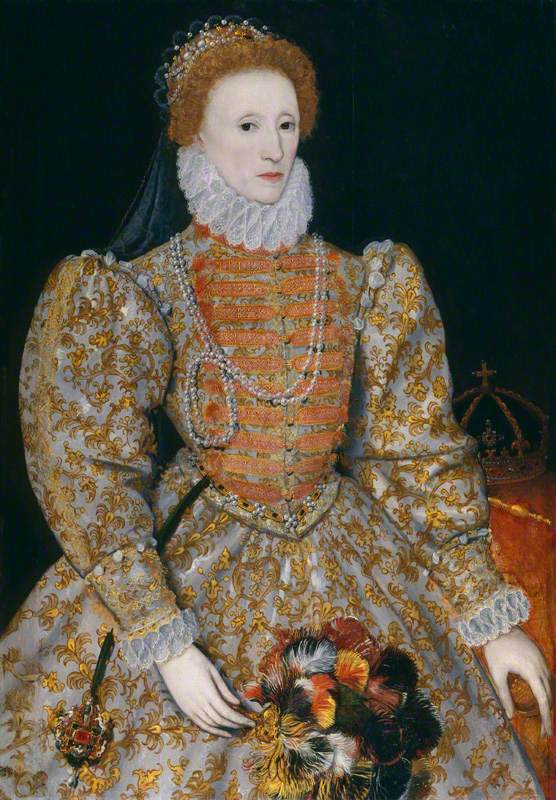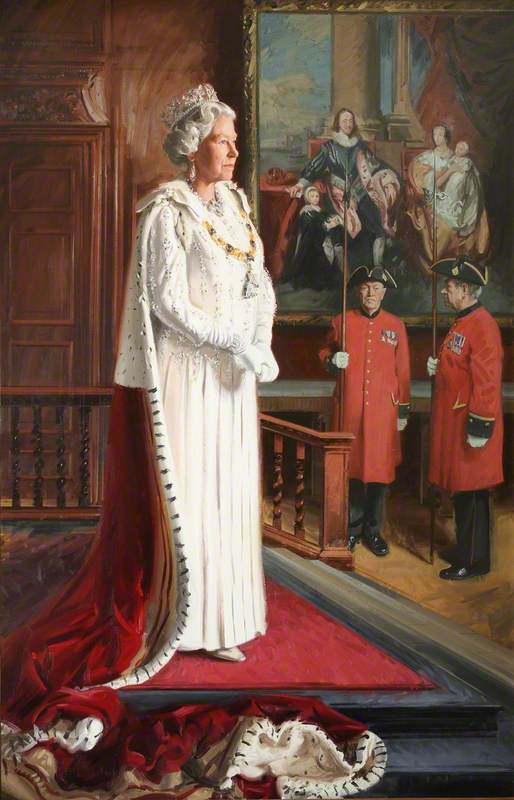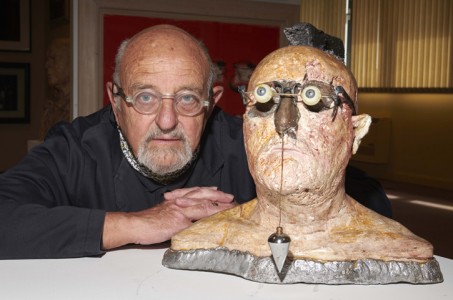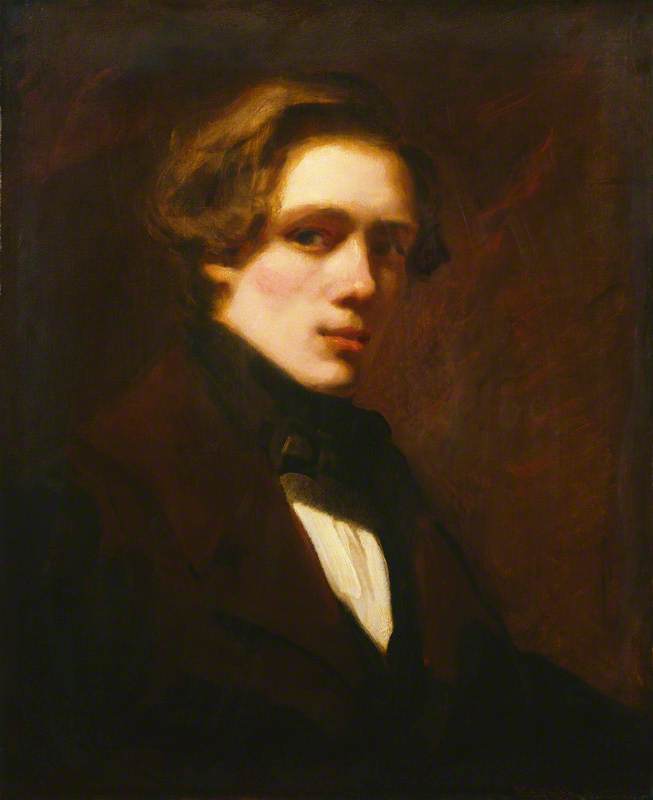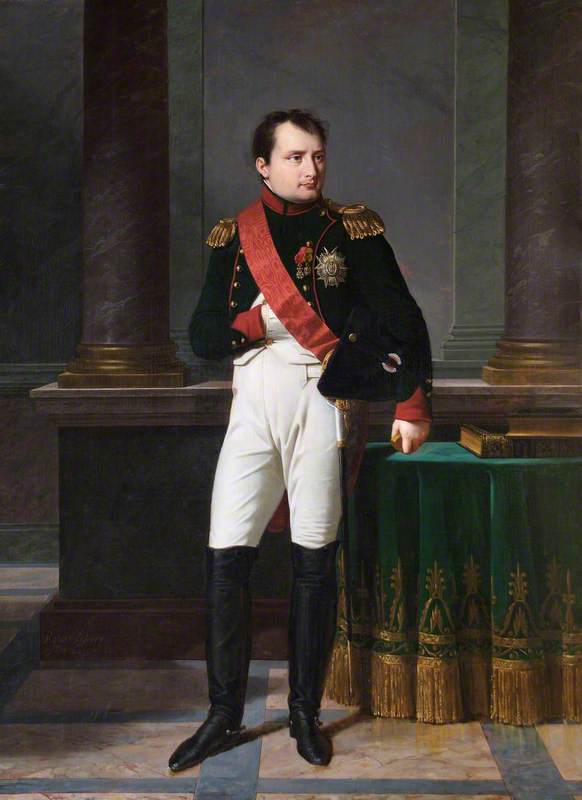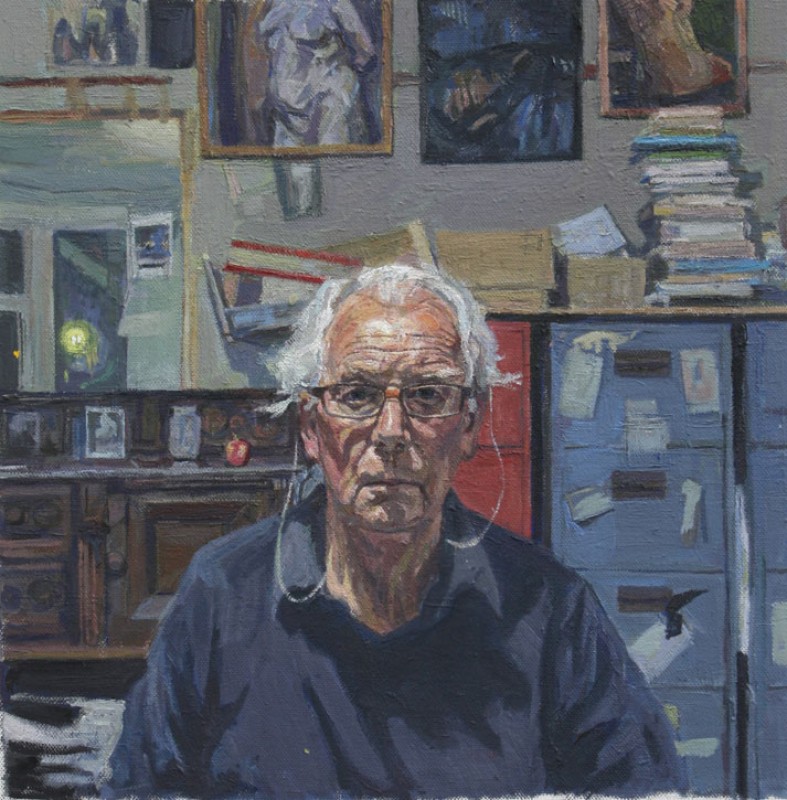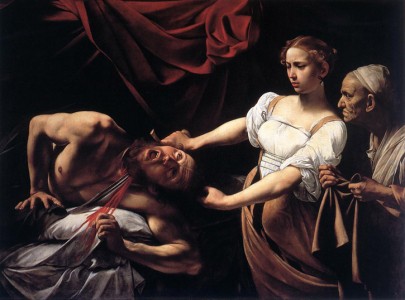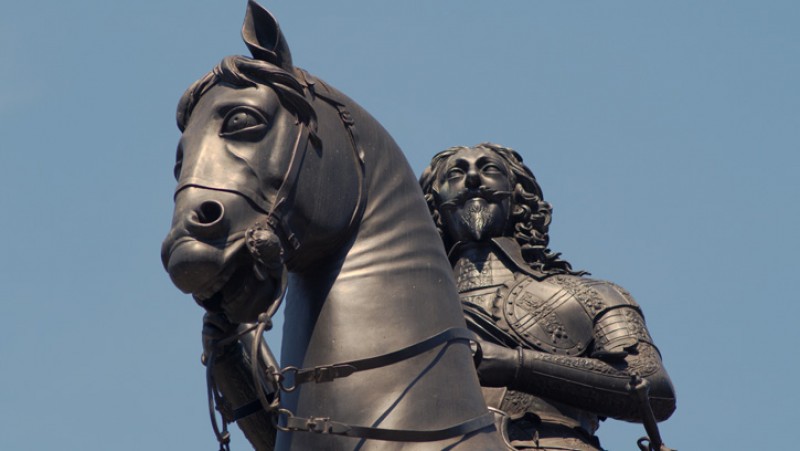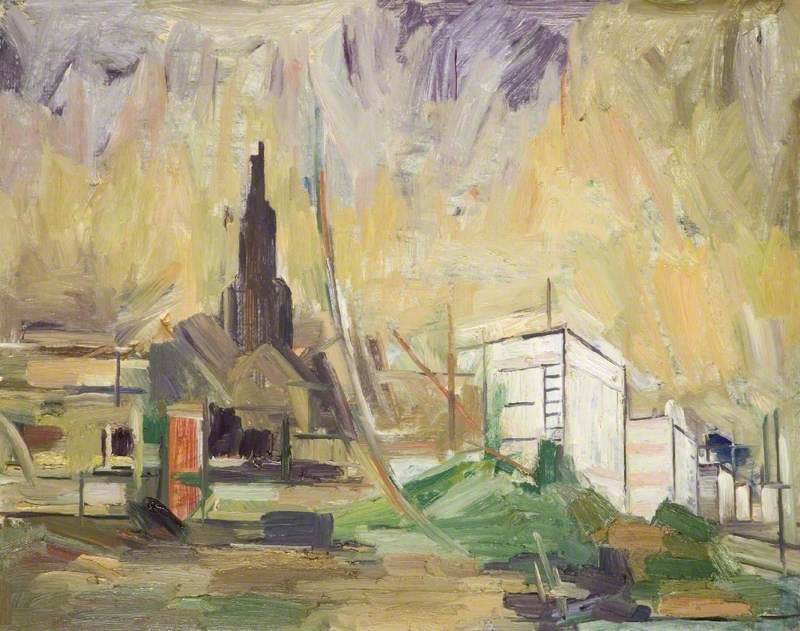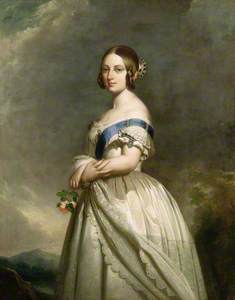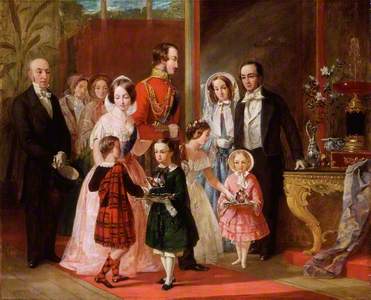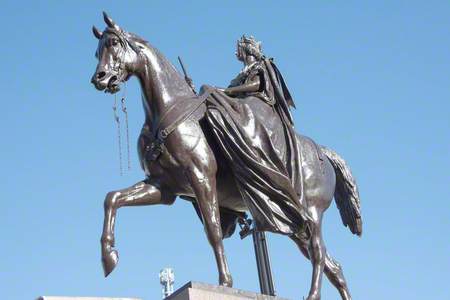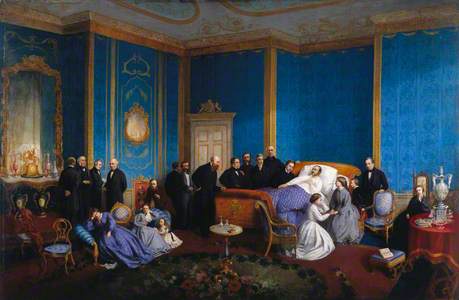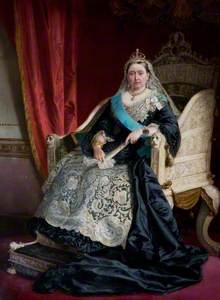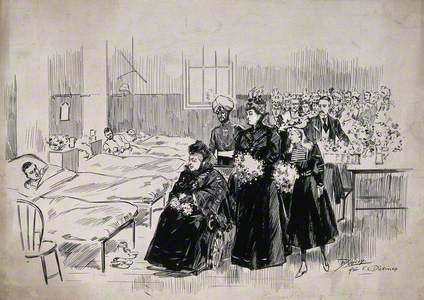Two hundred years ago, on 24th May 1819, Queen Victoria was born in Kensington Palace.
Queen Victoria (1819–1901)
after 1842
Franz Xaver Winterhalter (1805–1873) (copy after) 
A regal matriarch often imagined as an austere, dowdy and petite widower (she was only 4ft 11in), the 'Victorian' era has become synonymous to the personality and image of the Queen. The age is also associated with puritanical ideals, industrialisation and arrogant imperialism, not to mention the technological advancement of photography. As a result, Queen Victoria was the most photographed and painted monarch to have ever lived (at that time). A fiercely intelligent woman who acknowledged that her image was instrumental to her relationship with the public, some argued that she was the first royal to grasp the camera's potential power as a 'political weapon'.
It is likely that she regarded painting in the same way. Here's a look at some of the many depictions of her on Art UK.
Childhood
Victoria spent her childhood at Kensington Palace, where she had a sheltered upbringing due to the imposed code of discipline named the 'Kensington System'.
Queen Victoria (1819–1901), as a Child
early 19th C
Martin Archer Shee (1769–1850) 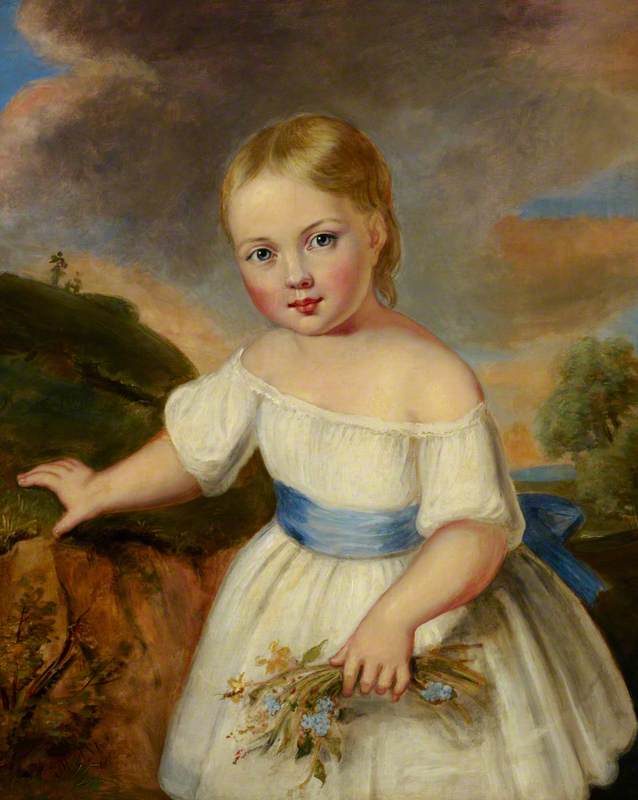
Painted in the early nineteenth century by Martin Archer Shee (1769–1850), here a young Victoria is shown as a healthy, rosy-cheeked child holding wildflowers. However, Victoria was rarely allowed to run free and wild in nature. We know that her childhood was strictly supervised, claustrophobic and mostly spent behind the closed doors of the palace.
Here, Victoria is shown on the lap of her mother – the Duchess of Kent, Maria Louise Victoria of Saxe-Coburg-Saalfield. Victoria's father (Prince Edward, Duke of Kent and Strathearn) died of pneumonia when she was just eight months old, meaning that her mother and her advisor Sir John Conroy oversaw Victoria's childhood.
This painting was executed in 1827 by the artist William Fowler (1796–1870). Victoria is most likely eight or nine years old.
Becoming Queen and Coronation
The Coronation of Queen Victoria
1839 or before
Edmund Thomas Parris (1793–1873) 
'Today is my eighteenth birthday! How old! and yet how far am I from being what I should be.' – Queen Victoria
Queen Victoria Receiving the News of Her Accession at Kensington Palace, 20 June 1837
1909
Frederick Parsons Shuckard (1844–1926) 
Victoria became Queen weeks after her eighteenth birthday, in June 1837. Her accession brought the end of over a century of male Hanoverian rule – due to the death of her father and his three elder brothers without legitimate issue.
Upon becoming Queen, she quickly released herself from the grips of Conroy and her mother (she later described Conroy as a 'demon incarnate'). Shortly after, she made Buckingham Palace the official royal residence in London. When Parliament granted her an annuity of £385,000 she became the richest woman in the world. The pretty, young and virginal Queen received a mass of letters from admirers, countless proposals of marriage and was subjected to the attentions of numerous stalkers.
Queen Victoria (1819–1901), in Coronation Robes
1837
Alfred Edward Chalon (1780–1860) 
Victoria was coronated on 28th June 1838 in Westminster Abbey, an event painted by a large number of artists. Swiss artist Alfred Edward Chalon (1780–1860) painted this portrait of the Queen in her ceremonial Coronation gowns in 1837.
Queen Victoria (1819–1901), in Her Coronation Robes
1838
Charles Robert Leslie (1794–1859) 
Anglo-American artist Charles Robert Leslie (1794–1859) painted this different version of the event the following year. Victoria is shown wearing the Dalmatic Robe as she receives the Sacrament. She is depicted before wearing the Crown and jewels. Leslie painted a larger version of this scene, which can be found in The Royal Collection. Victoria adored the larger version so much that she quickly bought the painting.
English Romantic painter John Martin (1789–1854) painted the interior of Westminster Abbey at the Queen's Coronation.
Early years as Queen
During the early years of her reign, the young Queen was advised by Prime Minister Lord Melbourne.
This painting by Italian painter Agostino Aglio (1777–1857) was finished in 1838.
The following year, the Whigs lost the election due to only having a minority rule, which resulted in The Bedchamber Crisis. Lord Melbourne resigned and the Queen reluctantly asked Robert Peel to form a new Conservative government. However, when Victoria refused to dismiss her Ladies of the Bedchamber upon Peel's request, (many of her closest female friends were wives of leading Whig politicians), a political fiasco ensued. Peel refused to become Prime Minister. The event marked Victoria's refusal to easily obey the wishes of Parliament and she was criticised.
Here, Victoria is depicted wearing the traditional Robes of State painted by Scottish painter David Wilkie (1785–1841).
A monarch who oscillated between actively engaging in politics and reluctantly following affairs of state, she once wrote: 'I love peace and quiet, I hate politics and turmoil. We women are not made for governing and if we are good women, we must dislike these masculine occupations. There are times which force one to take interest in them, and I do, of course intensely.'
Marriage and motherhood
Queen Victoria married her first cousin Prince Albert in 1840. In her diary, Victoria wrote: 'Albert really is quite charming, and so excessively handsome... a beautiful figure, broad in the shoulders and a fine waist; my heart is quite going.'
His Royal Highness Prince Albert (1819–1861)
Franz Xaver Winterhalter (1805–1873) (after) 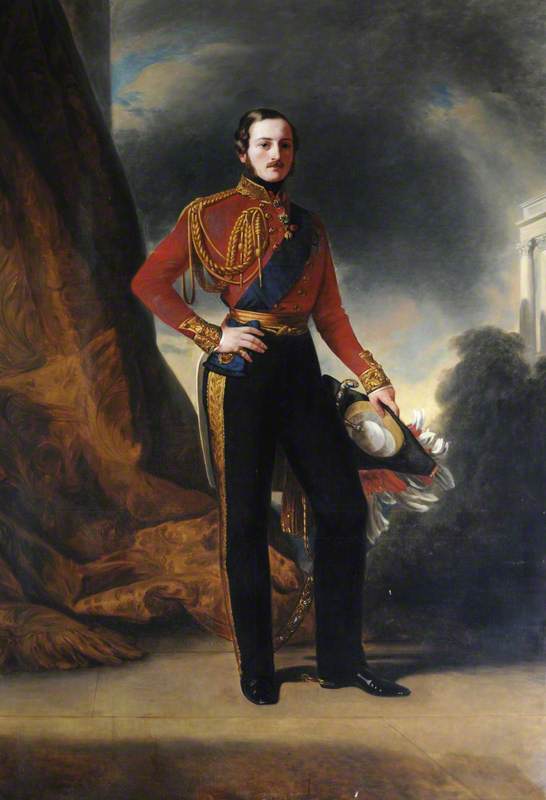
After their marriage, Victoria relied less on her ladies-in-waiting and allowed Prince Albert to take the reins (upon the advice of her older male advisors). In total, they had nine children together, with the Queen eventually becoming the grandmother to 42 grandchildren. In 1854, the Royal family was captured by photographer Roger Fenton.
Thomas Younghusband and His Family Meet Queen Victoria and Her Family at Crystal Palace
c.1854
C. Wells (active mid-19th C) 
Artist Franz Xaver Winterhalter (1805–1873) painted both Prince Albert and Queen Victoria multiple times. He became their official portraitist and was even entrusted to paint more private images for the couple. In 1843, the Queen commissioned a secret portrait from Winterhalter as a gift for Albert's 24th birthday, in which she is informally dressed and her hair hangs loose.
Due to her interest in photography, Victoria commissioned Bryan Edward Duppa to take a photograph of her for Prince Albert.
Queen Victoria (1819–1901)
1864
Franz Xaver Winterhalter (1805–1873) (after) 
Assassination attempts and equestrian portraits
Queen Victoria (1819–1901), on Horseback
c.1846
Alfred d'Orsay (1801–1852) 
Queen Victoria faced a number of assassination attempts throughout her reign. The first was in 1840 by a man called Edward Oxford, who tried to shoot her when she was four months pregnant with her first child. Oxford was arrested and charged of treason, and later transported to Australia after he was declared insane. In total, there were at least six attempts to assassinate Victoria, all of which were (obviously) unsuccessful.
Queen Victoria (1819–1901)
c.1850–1852
Franz Xaver Winterhalter (1805–1873) (after) 
Painterly depictions of the Queen on horseback increased after her accession. Reminiscent of Roman emperors and Napoleon, equestrian portraits date back to antiquity and convey not only an image of high status, but also chivalry and courage. Perhaps in the face of increasing threats and hostility, the Queen was consciously presenting an image of strength, adopting a traditionally masculine pose. Artist Sir Francis Grant (1803–1878) painted a young Victoria riding on horseback a few times, including this one below.
As was customary for women of the era, Victoria rode side-saddle. This tradition was to preserve a woman's modesty and ensure that her heavy, long skirts did not lift up to reveal her legs beneath.
The Great Exhibition and expanding empire
By 1850, Victoria had given birth to seven children. By the start of this decade, Britain had grown economically due to the expansion of its colonies, gaining control of Hong Kong and New Zealand, as well as most of India (through the East India Company).
The Opening of the Great Exhibition by Queen Victoria on 1 May 1851
1851–1852
Henry Courtney Selous (1803–1890) 
In 1851, the Great Exhibition opened in the Crystal Palace, Hyde Park, an event championed by Prince Albert alongside Henry Cole – who was instrumental in developing the Victoria and Albert Museum. A staggering six million people were estimated to have visited the Great Exhibition, with at least one-third of the British population attending. The money was used to fund the establishment of the V&A.
The Opening Ceremony of the Great Exhibition, London
1851
James Digman Wingfield (1800–1872) 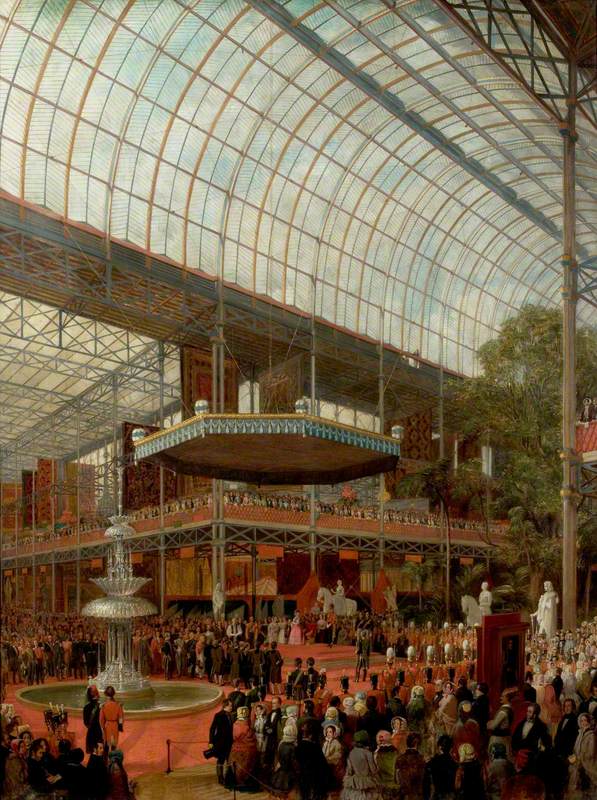
Queen Victoria opened the Exhibition on 1st May 1851. Her participation at the ceremony was criticised, with some Conservative politicians fearing that the huge mass of visitors could spark revolutionary activity or another assassination attempt. Among the many 'colonial' attractions at the Exhibition was the Koh-i-Noor diamond, which in 1849 had been acquired by Queen Victoria during the annexation of the Punjab in India and was once known as the largest diamond in the world. Looking back at it through today's eyes, the Great Exhibition could be seen as a pompous way for the British to showcase their imperialist achievements, technological advancements and colonial dominance. It placed Britain, Queen Victoria and Prince Albert on the international stage.
Painted by Thomas Jones Barker (1815–1882), Victoria is shown at Windsor Castle receiving an ambassador from East Africa (most likely based on Ali bin Nasr, governor of Mombasa), to whom she is presenting a Bible. This imagined painting reflects prevailing Victorian attitudes, as well as a popular anecdote involving the Queen that was circulating in the 1850s. After being asked by a foreign diplomat a question along the lines of: 'How has Britain become the most powerful nation on earth?', the Queen allegedly handed him a Bible and responded: 'Tell the Prince that this is the Secret of England's Greatness.'
Death of Prince Albert and widowhood
In 1861, Prince Albert – who by then had become Prince Consort – died aged 42 of typhoid fever. His unexpected death was a huge blow for the Queen, who had married him for love and was also reliant on him for matters of state. He shared her workload and was her closest friend and advisor, not to mention the father of their nine children.
The Queen apparently had a plaster cast made of Albert, which she slept next to after this death.
Queen Victoria
(copy after an original of 1899 by Heinrich von Angeli) 1900
Bertha Müller (1848–1925) 
Following his death, the Queen retreated from public life as she entered a long period of mourning from which she never quite recovered. She refused to open Parliament on several occasions and continued to wear black – mourning dress – for the rest of her life, earning the nickname the 'Widow of Windsor'. It seems as if she consciously changed her public-facing image at this time, choosing to appear as a woman in a perpetual state of mourning, no longer a fresh-faced young woman.
Housed in the Wellcome Collection, this picture above shows the moment of Albert's death. Apparently, the Queen was horrified by the existence of the picture and considered buying it in order to have it destroyed. Ultimately, it survived and was bought by Henry S. Wellcome in 1924. The artist has still not been identified with certainty.
Princess Beatrice of Battenberg; Queen Victoria
late 1860s (?) or early 1870s
unknown artist 
Empress of India
In 1876, Victoria became the Empress of India. In 1858, after the bloody Indian Rebellion and dissolution of the East India Company, India came under the direct rule of the Crown, marking the beginning of what was known as the British Raj. The title Empress (or Emperor) of India was eventually abolished after Indian independence in 1947.
Queen Victoria (1819–1901)
1887
George Dunlop Leslie (1835–1921) and James Hayllar (1829–1920) 
By 1870, the British Empire had extended to include Zanzibar, Fiji, Cyprus, Bechuanaland, Somaliland, Kenya, the New Hebrides, Rhodesia and Uganda.
Golden Jubilee
On 20th June 1887, Queen Victoria celebrated her Golden Jubilee, marking 50 years of her reign.
To commemorate the event, leaders and monarchs from 50 European countries were invited to London to attend a service at Westminster Abbey, an event painted by artist William Ewart Lockhart (1846–1900).
Golden Jubilee Portrait of Queen Victoria
(copy after a photograph by Alexander Bassano) 1897
unknown artist 
Victoria said about her Jubilee parade: 'The crowds were quite indescribable and their enthusiasm truly marvellous and deeply touching.'
Diamond Jubilee and final years
Queen Victoria's Diamond Jubilee
1897–1899
Gennaro d' Amato (1857–1947) 
Ten years later, Queen Victoria celebrated her Diamond Jubilee aged 78 on 22nd June 1897, marking the first time the phrase had been used in Britain. The previous year, she had surpassed George III as Britain's longest-reigning monarch.
Sketch of Queen Victoria Attending Her Diamond Jubilee
1897
William Ewart Lockhart (1846–1900) 
During the Boer War, Victoria visited wounded soldiers in military hospitals, shown below.
Queen Victoria died aged 81 on 22nd January 1901 at Osborne House on the Isle of Wight, marking the end of the Victorian era. Her state funeral on 2nd February 1901 was attended by thousands.
The Funeral Procession of Queen Victoria Passing through Hyde Park, London
1901
Mary Edith Durham (1863–1944) 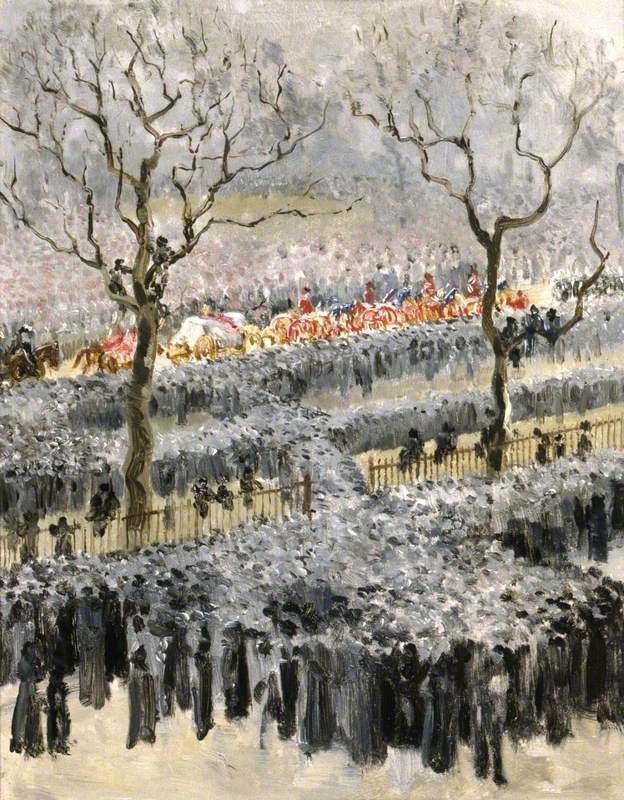
A Queen whose life has been perennially popular (especially with the release of television shows and films such as ITV's Victoria), today the public still can't get enough of the long-reigning monarch.
Moreover, Victoria's relationship to both painting and photography remains fascinating today – two mediums undergoing rapid transformation during her reign. While a young Victoria seemed anxious about the public's opinion, after the death of Albert and her withdrawal from the public eye, she clearly lost interest in what the public thought of her. Such an attitude, which has now come to define the legacy of Queen Victoria, was embodied in her statement: 'The important thing is not what they think of me, but what I think of them.'
Lydia Figes, Content Creator at Art UK









